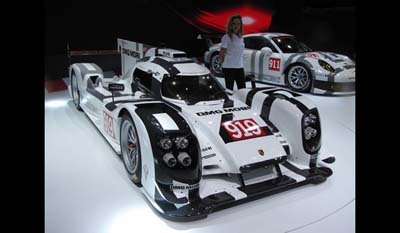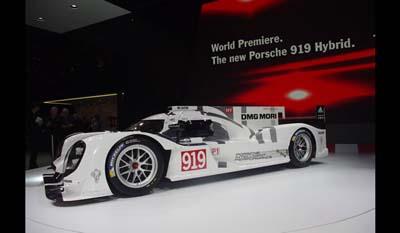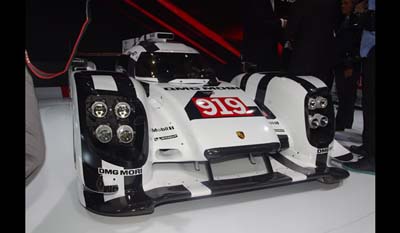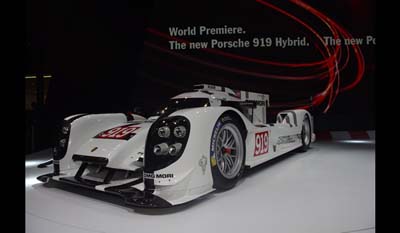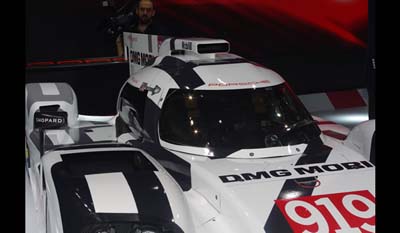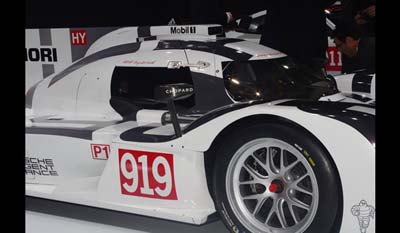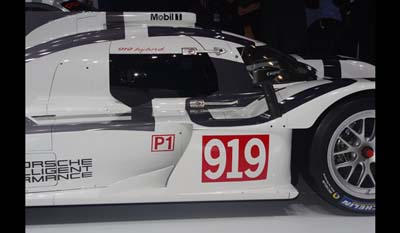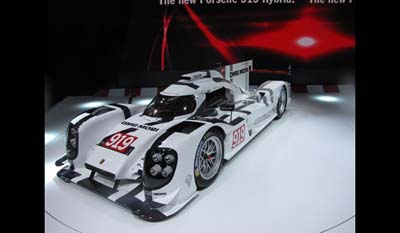Porsche 919 Hybrid LMP1-H WEC Le Mans 2014
Porsche is returning to the top category of the famous endurance race classic at Le Mans and the World Endurance Championships (WEC) for sports cars with its newly developed Porsche 919 Hybrid. The LMP1 prototype, which is designed for extreme efficiency, is the most complex race car that Porsche ever put on wheels. It serves as a research platform for fundamental technology to be used in future production models, with its combination of two different energy recovery systems and a downsizing turbocharged engine. So the real winner of Porsche factory racing is already clear: it is the customer. Maximum efficiency of all elements as development goalPorsche engineers are taking on the challenges of the WEC regulations with innovative solutions. The development of the Porsche 919 Hybrid began in mid-2011 – literally on a blank sheet of paper. As newcomers, the developers had to do without the greater experience that their competitors in the LMP1 category enjoyed. The exceptional efficiency of the highly complex technology of the Porsche 919 Hybrid is the result of a carefully balanced overall concept. From the combustion engine to the energy recovery systems, chassis and running gear, aerodynamics and driver ergonomics, the sum of all individual components forms an exceptionally effective unit. It all serves one goal: a maximum of sporty performance within tight fuel economy constraints. Then the front generator is operated as a single electric motor and drives the two front wheels via a differential in the acceleration phases. This gives the Porsche 919 Hybrid a temporary all-wheel drive system, because the petrol engine directs its power to the rear wheels in a conventional way. Powerful hybrid drive for the 8 megajoule premiere class
Intelligent management of this additional available energy assumes a special role here. Of course, the strategic focus of the racing engineers is always on the most efficient use of available power. This means an optimal lap time. The driver can choose from several automated drive modes that have an effect on vehicle dynamics as a function of the traffic situa -tion, course layout and weather conditions. At this point, the developers made use of knowledge gained by Porsche with the 911 GT3 R Hybrid, including at the 24-hour race on the Nürburgring. The allowable petrol fuel consumption depends directly on the amount of electrical energy that the driver can call up during a lap in what is known as the Boost function. Race rules distinguish between four levels ranging from 2 to 8 megajoules (MJ). Porsche is developing the 919 Hybrid for the “Premiere class" with an energy recover capacity of 8 MJ. This requires the use of high-performance energy recovery and storage systems, which need to be sized larger and heavier. A flow meter device also limits the amount of fuel flow. Example of Le Mans: Here, the turbocharged petrol engine, which is driven at full load for 75 per cent of the 13.65 kilometre lap, only has 4.64 litres of fuel available. In the 2-MJ class, the figure is 5.04 litres. Factors for success: Low weight and efficient aerodynamicsIn motorsport and in the production models, Porsche has always devoted a lot of attention to the theme of lightweight design. This continues to be the case with the Porsche 919 Hybrid. According to the race regulations, the Porsche 919 Hybrid must not exceed a length of 4,650 mm and a height of 1,050 mm, and vehicle width must be between 1,800 and 1,900 mm. The car's aerodynamics have been fine-tuned in over 2,000 hours of wind tunnel testing since February 2012. Aerodynamics make an important contribution to the overall efficiency of the race car and reduce air drag while supplying the increased cooling air needed for the hybrid drive and the downforces needed for high speeds in bends. The aerodynamic design of the Porsche 919 Hybrid can be modified for different course characteristics. Safe and functional: Optimal working conditions for the driverDriver ergonomics play a crucial role, especially in endurance races like the 24 Hours of Le Mans. The motorsport experts therefore devoted a lot of attention to the layout of the cockpit. The drivers have a good view of race events thanks to their somewhat higher seat position in the chassis compared to the previous LMP1 rules. In night-time hours, LED fourpoint headlights that were specially designed for Porsche provide for clear visual conditions. Their distinctive form was created in cooperation with Style Porsche, the design studio for production models. Here too, this modern lighting technology will benefit all Porsche customers in the future. Countdown: - Around 200 employees and 6 drivers excitedly look forward to the season startIn mid-May 2011, Porsche decided to return to the World Endurance Championship and the 24 Hours of Le Mans with a LMP1 factory team. Consequently, the motorsport centre in Weissach was expanded considerably, and a service garage and administration building were added. Today, around 200 employees participate in the engineering, construction and use of the Porsche 919 Hybrid. Fritz Enzinger (age 57) assumes overall management of the LMP1 project. Responsible for technology is engineer Alexander Hitzinger (Dipl.-Ing.,age 42). Andreas Seidl (age 38) is team leader. The cockpits of the two Porsche 919 Hybrid cars are shared by experienced Le Mans Porsche driver Timo Bernhard (Germany, age 33), Romain Dumas (France, age 36) and Marc Lieb (Germany, age 33) as well as Brendon Hartley (New Zealand, age 24), Neel Jani (Switzerland, age 30) and former Formula-1 driver Mark Webber (Australia, age 37). Related articles: see Porsche LMP1 for 2014 WEC and Le Mans Porsche 911 GT3 R Hybrid Flywheel Electric Storage Racing Prototype 2010 Porsche Plug-in Hybrid 918 Spyder 2013 Wallpapers of the Porsche 919 Hybrid LMP1-H WEC Le Mans 2014 (click on image to enlarge)
Related review
|
|||||||||||||||||||||||||||||||||||||||||||||
|---|---|---|---|---|---|---|---|---|---|---|---|---|---|---|---|---|---|---|---|---|---|---|---|---|---|---|---|---|---|---|---|---|---|---|---|---|---|---|---|---|---|---|---|---|---|








